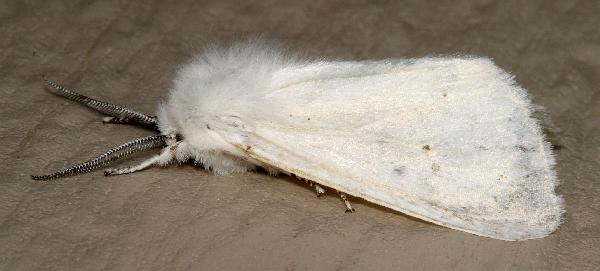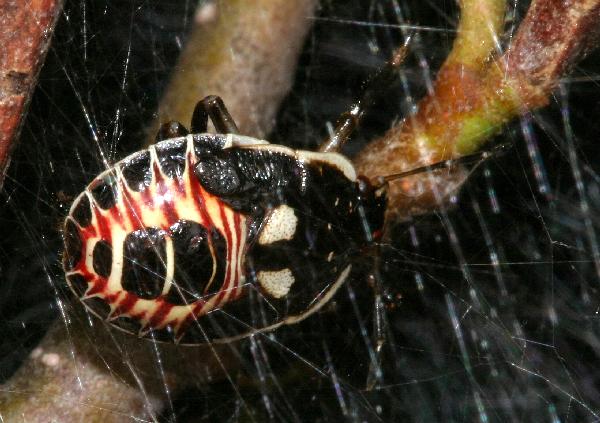Fall webworms, and “Art Deco Bugs”
This white moth came to our porch light on July 4, 2011. Its wings look a bit ratty at the edges, so this was probably near the end of its life. Which suggests that the main flight period for this species was probably earlier, maybe most of the month of June.
After a bit of searching, I think it is most likely an adult Fall Webworm, Hyphantria cunea. These are spring-flying tiger moths that vary quite a bit in their color pattern. Further south they typically have heavily spotted wings, but in the north they are nearly pure white, like this one.
This isn’t a new species for the site, because I already have some decent pictures of the webworm caterpillar. But, I didn’t have pictures of the silk “tent” that they make over the tips of branches in the trees they are browsing on. So, this year when we found a bunch of them on a small tag-alder tree out back on August 4, 2011 (exactly a month after finding the adult moth), I went to get some pictures of them in their webbing.
Their tents really do look superficially like the ones made by eastern tent caterpillars, except that the tent caterpillars generally build theirs in the crotches of branches, while the webworms build more out on the branch tips.
While taking pictures, we noticed that there was something other than caterpillars in the tent. I’ve circled a very colorful bug nymph that was in there, too. They had rather intricate tracing that makes them look almost like fancy laquerwork. Sandy called them “Art Deco Bugs”.
On further checking, we found quite a number of the bugs, both large (about 8 mm):
and small (about 5 mm):
These are clearly some sort of stink bug nymphs, family Pentatomidae. There are a number of stink bugs with red and black nymphs (and I’ve even photographed such nymphs before), but they change color a lot as they grow up and so identifying the species from the nymphs is hard.
It is possible that these are typical plant-sap-sucking bugs, and that their presence in the webworm nest was a pure coincidence (or maybe a case of taking an available shelter from predators). But somehow, I don’t think so. For one thing, there is an entire subfamily of predatory stink bugs (Asopinae) which tend to have colorful nymphs like this.
And, in fact, these look rather a lot like nymphs of either the Two-Spotted Stink Bug, Perillus bioculatus, or one of the Spined Soldier Bugs, genus Podisus. Both of which are definitely predatory. And the proboscis visible underneath this one certainly looks stout enough to be used to attack other insects.
And for another thing, we went back just a week later, and the webworm nest was empty. Not only the webworms were gone, but the bugs were gone, too. This strongly suggests that the bugs were actively following the webworms, otherwise they would have kept hanging out in the webbing even after the caterpillars moved on. And why else would they be following them, if not to devour them?
Webworms normally disperse from their webs after their last molt before pupating, so it is possible that a lot of them just wandered off. But given how many of the bugs there were in the web, I suspect that the majority of the caterpillars got eaten.
Note added later: We found some more of these nymphs and raised them to adulthood. They did turn out to be predatory, and they are Podisus placidus, which don’t appear to have a common name. So I’ve decided to call them “Webworm Destroyers”.
Comments are closed.









Just stumbled into your site & this page. Is it possible that the nymphs have co-evolved with the caterpillars and are there for protection?
It is possible, although I’d need to find more webworm nests to see whether these nymphs actually do specifically hang out there. And then observe a few of them over several seasons to be sure if this was a particular adaptation, or just happenstance.
What purpose do these wild colors serve?
I know they stink bug has a symbiotic relation with web worm predators…
They attract the predator which bribes the stinkbug with sex and drugs…
Yeah, and then ….
(Ok, your turn)
But seriously, what do stink bugs eat? sap?
The worms eat the leaves, right?
Hi, Fred. I see you’ve found me 🙂
Most of the time, insects with wild colors are advertising that they are toxic, and predators have learned not to eat things that look like that.
And yes, most stink bugs eat sap, but I’m pretty sure that these are eating caterpillars.
The worms are such saps!
Hi there we have been trying to identify this same nymph and were delighted to find your website. We have spotted your “art deco” nymph on thee different occasions eating a Lilly beetle. Did you ever find out a proper name for it? PS: I do have a photo of it and the Lilly beetle.
Tammy:
Nope, I never did get a better ID.
What’s a Lilly beetle?